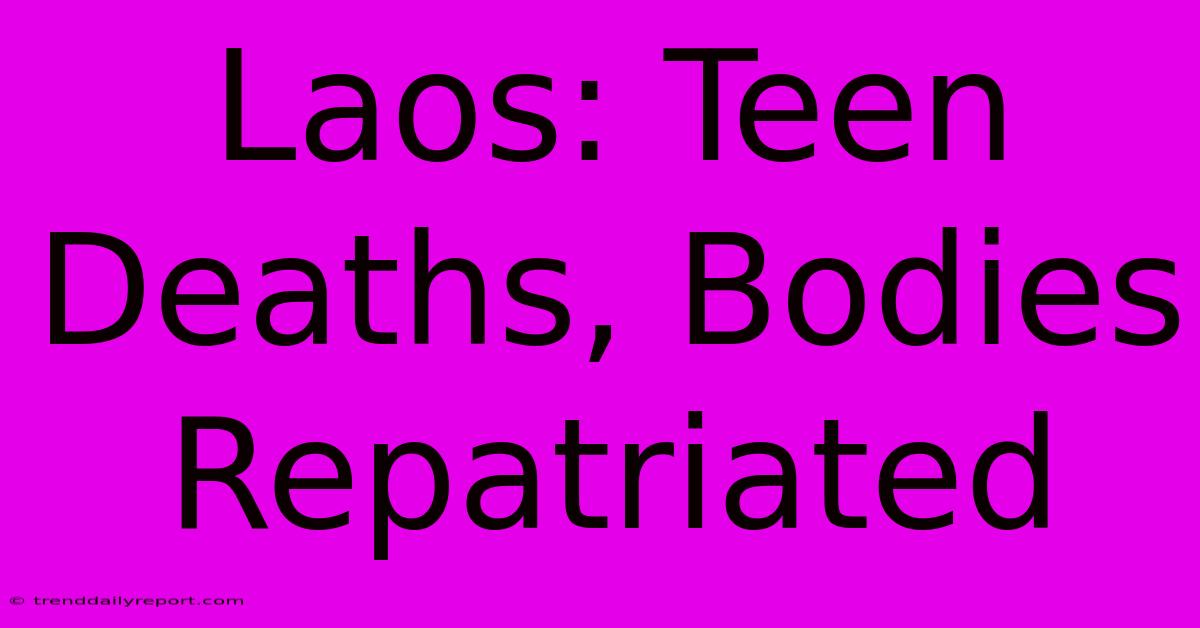Laos: Teen Deaths, Bodies Repatriated

Discover more detailed and exciting information on our website. Click the link below to start your adventure: Visit Best Website Laos: Teen Deaths, Bodies Repatriated. Don't miss out!
Table of Contents
Laos: The Heartbreaking Journey of Repatriating Teen Deaths
This isn't easy to write, you guys. I've been meaning to tackle this topic for ages, but the sheer sadness of it… well, it's been a bit of a block. But I know it's important. Too many families in Laos are facing this unthinkable pain, and we need to talk about it. We need to understand the issues surrounding teen deaths in Laos and the incredibly difficult process of repatriating their bodies.
I first learned about the complexities of this issue when I was working with a non-profit a few years ago. We were helping families who'd lost loved ones abroad—mostly migrant workers—and the struggles they faced were immense. The paperwork alone was enough to make your head spin. Imagine, you’re already grieving, heartbroken, and then you're hit with a mountain of bureaucratic hurdles. It's a nightmare scenario.
The Challenges of Repatriation in Laos
One case sticks with me. A young woman, barely 19, died in Thailand. She was working there to support her family. Getting her body back to her village in Laos was an absolute ordeal for her parents. They were dealing with grief, language barriers, unfamiliar legal processes, and the financial strain of international transport costs. It was gut-wrenching to watch.
The challenges are multi-faceted. First, financial constraints are a major hurdle. International repatriation is expensive; the costs can easily bankrupt a family already struggling with loss. Then there's the bureaucracy. The paperwork involved—death certificates, visas, permits—is extensive and often confusing, especially if you lack access to legal assistance or don’t speak the language. And let's not forget the emotional toll. Losing a child is devastating; navigating the logistical nightmare of repatriation adds another layer of unimaginable stress.
There are also logistical challenges. The infrastructure in rural Laos isn’t always sufficient to handle the transportation of bodies. Getting a body from a remote village to the nearest airport can be a significant undertaking, especially during the rainy season. Plus, there are potential issues with corruption, which can further delay the process and add to the families' burden.
Understanding the Causes of Teen Deaths in Laos
Understanding why so many teens are dying in the first place is critical. While precise data is hard to come by (another issue we need to address!), we know several factors contribute. Poverty forces many young people to migrate for work, often in hazardous conditions. Lack of education and awareness regarding safety and health further increases vulnerability. The accessibility of healthcare in rural areas remains a pressing concern, and substance abuse is another serious problem contributing to preventable deaths. Let’s be honest, it’s a complex web of interconnected problems.
Practical Steps to Improve the Situation
So, what can we do? I don't have all the answers, that's for sure. But here are a few ideas:
- Increased government support: Financial assistance programs to help families cover repatriation costs could make a huge difference. Simplifying bureaucratic procedures and providing clear information would also ease the burden.
- Non-profit involvement: Organizations providing legal aid, translation services, and emotional support can be invaluable to grieving families.
- Improved healthcare access: Investing in accessible healthcare, especially in rural areas, is crucial for reducing preventable deaths.
- Education and awareness campaigns: Educational programs focusing on safety, health, and responsible behavior among young people can prevent tragedies.
This isn't just a Laos problem; similar challenges exist in many developing countries. It requires a multifaceted approach involving government, NGOs, and the international community. It's a hard topic, but silence isn't an option. We need to keep talking about it, keep pushing for change, and keep supporting those families struggling with the unthinkable. We need to work towards a future where fewer families have to endure the pain of losing a child and the added burden of a difficult repatriation.

Thank you for visiting our website wich cover about Laos: Teen Deaths, Bodies Repatriated. We hope the information provided has been useful to you. Feel free to contact us if you have any questions or need further assistance. See you next time and dont miss to bookmark.
Featured Posts
-
5000 Signatures Demand General Election
Nov 27, 2024
-
Only Fans Paid Kate Nash
Nov 27, 2024
-
Barcelona Vs Brest Confirmed Starting 11
Nov 27, 2024
-
This Morning Row Bonnie Blues Plea
Nov 27, 2024
-
Taser Case Officer Employment Uncertain
Nov 27, 2024
